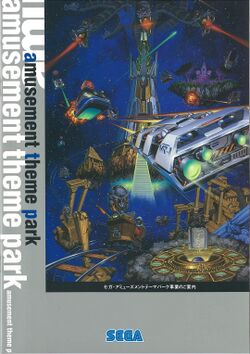Difference between revisions of "Amusement Theme Park"
From Sega Retro
m |
m |
||
| Line 1: | Line 1: | ||
[[File:Amusement Theme Park Concept.jpg|thumbnail|250px]] | [[File:Amusement Theme Park Concept.jpg|thumbnail|250px]] | ||
| − | + | '''Amusement Theme Park''' (アミューズメントテーマパーク), commonly abbreviated to "ATP", was a concept created by [[Sega]] to describe its indoor theme park venues during the 1990s, beginning with [[Osaka ATC Galbo]] and [[Yokohama Joypolis]] in 1994. The parks were designed to establish them as a major force in the out-of-home entertainment sector and expand their customer base through providing high-tech interactive attractions to families, with the addition of other amenities and the capacity for regular officially-held events. | |
| − | + | With many of the parks beset by managerial problems leading to poor business decisions and cashflow issues, the proposed target of at least 100 locations around the world by 2000 was never achieved. Thusly, the majority of the venues opened under the concept either closed permanently or downsized in the midst of a restructuring at the company, as well as a worldwide decline in the amusement industry. Out of the thirteen venues opened during its active period, only the flagship [[Tokyo Joypolis]] remains operational under [[CA Sega Joypolis]], though a small number of new parks including [[Qingdao Joypolis]] have also been developed since the discontinuation of the concept. | |
==History== | ==History== | ||
| Line 22: | Line 22: | ||
* [[Yokohama Joypolis]] (1994-07-20 - 2001-02-28) | * [[Yokohama Joypolis]] (1994-07-20 - 2001-02-28) | ||
* [[Ichikawa Galbo]] (1994-11-30 - 1999-03) | * [[Ichikawa Galbo]] (1994-11-30 - 1999-03) | ||
| − | * [[Yokkaichi Galbo]] (1995-03- | + | * [[Yokkaichi Galbo]] (1995-03-18 - 2008-02-20) |
* [[Niigata Joypolis]] (1995-12-09 - 2001-01-16) | * [[Niigata Joypolis]] (1995-12-09 - 2001-01-16) | ||
* [[Fukuoka Joypolis]] (1996-04-20 - 2001-09-24) | * [[Fukuoka Joypolis]] (1996-04-20 - 2001-09-24) | ||
Revision as of 22:18, 8 April 2021
Amusement Theme Park (アミューズメントテーマパーク), commonly abbreviated to "ATP", was a concept created by Sega to describe its indoor theme park venues during the 1990s, beginning with Osaka ATC Galbo and Yokohama Joypolis in 1994. The parks were designed to establish them as a major force in the out-of-home entertainment sector and expand their customer base through providing high-tech interactive attractions to families, with the addition of other amenities and the capacity for regular officially-held events.
With many of the parks beset by managerial problems leading to poor business decisions and cashflow issues, the proposed target of at least 100 locations around the world by 2000 was never achieved. Thusly, the majority of the venues opened under the concept either closed permanently or downsized in the midst of a restructuring at the company, as well as a worldwide decline in the amusement industry. Out of the thirteen venues opened during its active period, only the flagship Tokyo Joypolis remains operational under CA Sega Joypolis, though a small number of new parks including Qingdao Joypolis have also been developed since the discontinuation of the concept.
Contents
History
Background
Development
Launch
Active period
Decline
Legacy
Venues
Japan
- Osaka ATC Galbo (1994-04-14 - 2007-09-18)
- Yokohama Joypolis (1994-07-20 - 2001-02-28)
- Ichikawa Galbo (1994-11-30 - 1999-03)
- Yokkaichi Galbo (1995-03-18 - 2008-02-20)
- Niigata Joypolis (1995-12-09 - 2001-01-16)
- Fukuoka Joypolis (1996-04-20 - 2001-09-24)
- Tokyo Joypolis (1996-07-12)
- Shinjuku Joypolis (1996-10-04 - 2000-08-31)
- Kyoto Joypolis (1997-09-11 - 2002-08-22)
- Okayama Joypolis (1998-07-18 - 2018-09-03)
- Umeda Joypolis (1998-11-28 - 2018-05-06)
Overseas
- SegaWorld London (1996-09-07 - 1999-09-07)
- Sega World Sydney (1997-03-18 - 2000-11-12)
Promotional material
Magazine articles
- Main article: Amusement Theme Park/Magazine articles.

